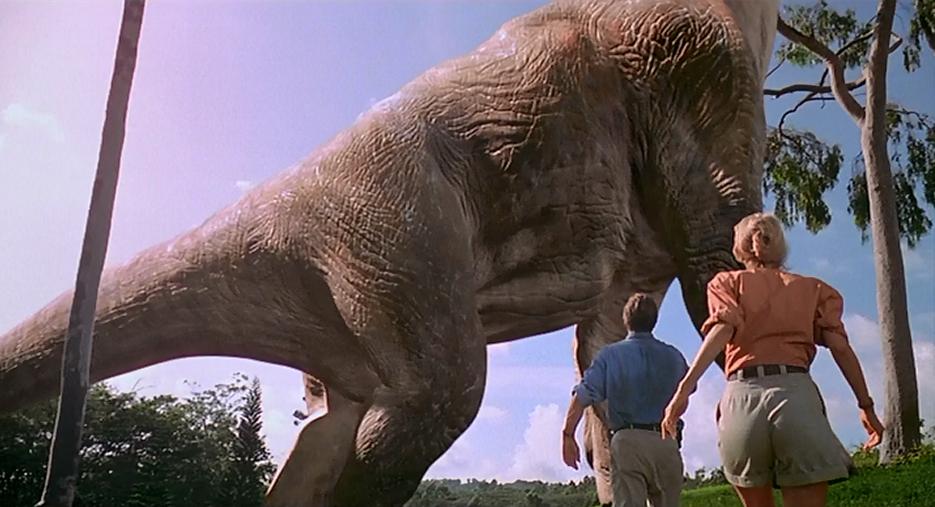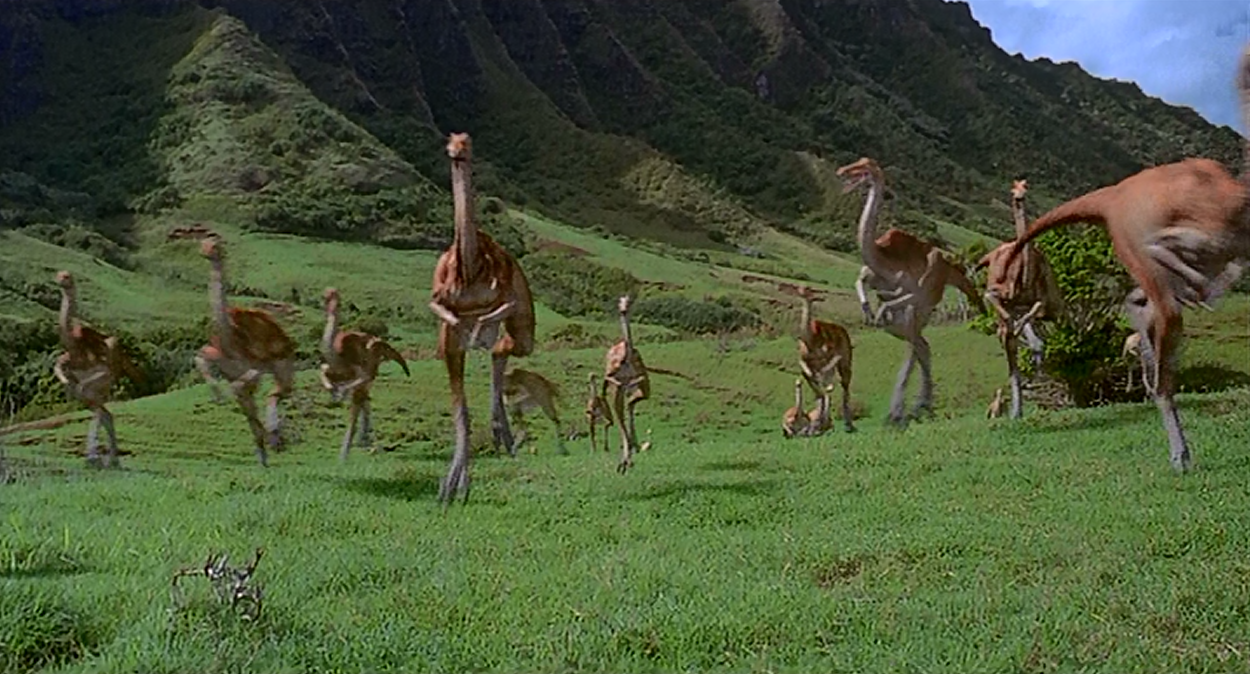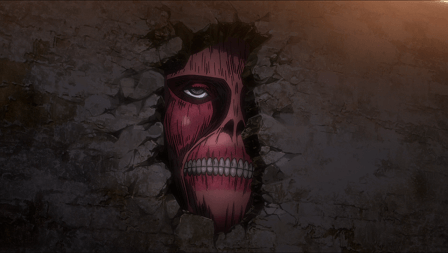The modern era of computer generated imagery was ushered in by 1993’s Jurassic Park. The Stephen Spielberg adaptation of Michael Crichton’s novel was a slam dunk. It was a huge hit and it changed the way movies would be made forever.
 Originally, the special effects team had plans to use stop motion animation to create the illusion of dinosaurs running amok. Phil Tippett, who received an Oscar for his special effects work on Return of the Jedi, would use his “Go-Motion” technique — an updated method of using miniatures and stop-motion animation to add motion blur to each frame for smoother and more lifelike movement — for dinosaurs in wide shots. Dennis Muren, who had previously supervised special effects on the Star Wars films and Spielberg classics like E.T. and Indiana Jones and the Temple of Doom, would lead the effects team at Industrial Light and Magic (ILM) in seamlessly combining all of the effects elements in post-production.
Originally, the special effects team had plans to use stop motion animation to create the illusion of dinosaurs running amok. Phil Tippett, who received an Oscar for his special effects work on Return of the Jedi, would use his “Go-Motion” technique — an updated method of using miniatures and stop-motion animation to add motion blur to each frame for smoother and more lifelike movement — for dinosaurs in wide shots. Dennis Muren, who had previously supervised special effects on the Star Wars films and Spielberg classics like E.T. and Indiana Jones and the Temple of Doom, would lead the effects team at Industrial Light and Magic (ILM) in seamlessly combining all of the effects elements in post-production.
 However, Spielberg wasn’t 100 percent happy with the wide test shots of the dinosaurs — they just weren’t photorealistic. So Muren and his ILM team, spurred by their revolutionary experience in designing and incorporating fully computer-generated characters into films like The Abyss and Terminator 2: Judgment Day, showed Spielberg an early CGI dino test of a group of Gallimimus skeletons running through a field.
However, Spielberg wasn’t 100 percent happy with the wide test shots of the dinosaurs — they just weren’t photorealistic. So Muren and his ILM team, spurred by their revolutionary experience in designing and incorporating fully computer-generated characters into films like The Abyss and Terminator 2: Judgment Day, showed Spielberg an early CGI dino test of a group of Gallimimus skeletons running through a field.
Spielberg was in awe of the ease of movement and realism of the effects, but he was still wary that they wouldn’t hold up under intense scrutiny — and he didn’t want to scrap Tippett’s practical animation talents altogether. So the director urged Muren and ILM to go further. When they came back with a CGI test of a fully rendered T. Rex walking across a field in broad daylight, the director decided to go full CGI.
While viewing Muren’s complete CGI test with Spielberg and the other members of the effects team, Tippett said, “I think I’m extinct.”
The words were prophetic. The days of stop-motion animation as an effect in movies were over. As amazing and mind-blowing as the stop motion effects were to audiences of the Ray Harryhausen movies from the 60’s and 70’s and into the early ’80’s with his final hit Clash of the Titans, that kind of effect on screen was no longer viable. Audiences had seen CGI in a huge way with Jurassic Park, and that which has been seen cannot be unseen.
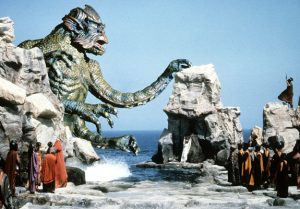 And here is the point that I have been trying to make in this series of blog posts. The CGI of 1993 changed the audiences’ perception. No longer would audiences who accepted without question the stop motion monsters from Clash of the Titans now accept anything less than the CGI dinosaurs of Jurassic Park. And, indeed, no one tried to give it to them. Stop motion animation moved into a niche. The art form was not dead, but it could never stand in for reality the way that it used to. It was all good and fine in its own oeuvre in films like Wallace and Grommit or Coraline or The Box Trolls, but it was becoming more and more a curiosity.
And here is the point that I have been trying to make in this series of blog posts. The CGI of 1993 changed the audiences’ perception. No longer would audiences who accepted without question the stop motion monsters from Clash of the Titans now accept anything less than the CGI dinosaurs of Jurassic Park. And, indeed, no one tried to give it to them. Stop motion animation moved into a niche. The art form was not dead, but it could never stand in for reality the way that it used to. It was all good and fine in its own oeuvre in films like Wallace and Grommit or Coraline or The Box Trolls, but it was becoming more and more a curiosity.
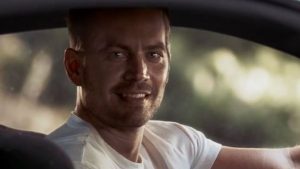 CGI, on the other hand, became the de rigeur method of creating realistic creatures, spaceships and environments, even replacing actors like recreating the late Paul Walker in a Fast and Furious sequel made after the star’s untimely death.
CGI, on the other hand, became the de rigeur method of creating realistic creatures, spaceships and environments, even replacing actors like recreating the late Paul Walker in a Fast and Furious sequel made after the star’s untimely death.
Even early CGI can’t cut it in movies anymore. Realistic CGI has come so far that it has become almost completely indistinguishable from reality. (I say almost, because there is currently a move back to practical effects in response to an overuse of CGI, but that’s a whole other topic).
 Audiences can look back at early CGI and marvel at how unsophisticated they seem today. Watch an episode of Syfy’s The Expanse, or even Syfy’s Battlestar Galactica and compare it to one of the “early adopter” science fiction shows like Babylon 5 or Seaquest and the contrast is startling. How, you may wonder, could I have accepted such crude, computery stand-ins for what is now obviously the state of the art?
Audiences can look back at early CGI and marvel at how unsophisticated they seem today. Watch an episode of Syfy’s The Expanse, or even Syfy’s Battlestar Galactica and compare it to one of the “early adopter” science fiction shows like Babylon 5 or Seaquest and the contrast is startling. How, you may wonder, could I have accepted such crude, computery stand-ins for what is now obviously the state of the art?
 Watch the first Jurassic Park and compare it to any more recent film; Guardians of the Galaxy, The Hobbit, or even Jurassic World. If you look closely, you can see the flaws. You can see the computers at work. What was mind blowing then is pedestrian today.
Watch the first Jurassic Park and compare it to any more recent film; Guardians of the Galaxy, The Hobbit, or even Jurassic World. If you look closely, you can see the flaws. You can see the computers at work. What was mind blowing then is pedestrian today.
And that’s the way the medium works. In the world of special effects, as in the world of art, we stand on the shoulders of giants. As titanic as their accomplishments were, we see even further for having the benefit of being able to stand on their shoulders.
We cannot look at art from before the 14th century, before the discovery of the secrets of perspective, and feel the same way about it. We cannot look at impressionism or cubism or any other art movement and see it the same way. We have come too far and seen too much to have the same experience that we had upon first being introduced to it.
CGI isn’t fine art. It’s commerce. It’s movie making. But it makes up the collective experiences that we have all seen together, no matter how far apart we are physically. The movies are a collective shared hallucination, and one that is becoming increasingly moved away from “real” reality. The birth, growth and development of the computer generated image has shown us amazing vistas and wondrous moments, but more than that it has shaped our expectations of what those vistas and moments should look like.
There’s no going back. A film that employs CGI that is not up to snuff gets soundly criticized and is fated to end up as a footnote, or worse, as an item on an internet list of the “Top Ten Worst CGI”
I started this series about CGI to try to make a point about audience perceptions and the development of an art form. I don’t know if I have come anywhere close to making it or getting across what I am trying to say. I had what I thought was a very clear idea of what that was when I began and after four parts and close to 4000 words (and one interruption) I’m not sure that I’m any closer.
Either way, this series has been somewhat less than popular with readers here at Amazing Stories, so it is well that it has come to an end. Next week I’ll go back to tackling less weighty subjects.
If I come back at all.

